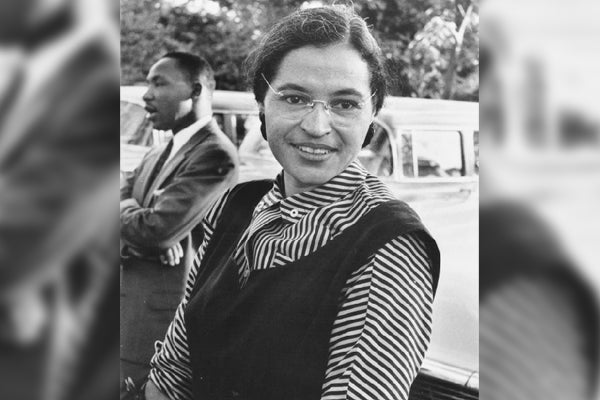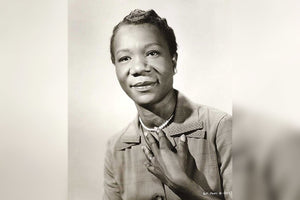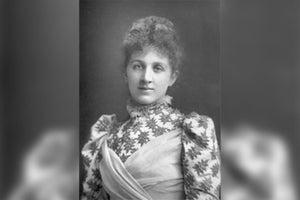Rosa’s Childhood
Rosa Parks was born Rosa Louise McCauley in Tuskegee, Alabama, United States, on 4th February 1913. Her mother, Leona Edwards, was a teacher and her father, James McCauley, was a carpenter. She grew up on a farm just outside the city of Montgomery, Alabama.
After her parents separated, her mother took her and her younger brother Sylvester to live with their grandparents in Pine Level.
Her grandparents were both former slaves and strong believers in equal rights for black and white people.
Rosa was a small child who was often unwell, and she suffered from chronic tonsillitis.
Rosa had experienced the racial inequality in Alabama many times as a child.
In one experience, Rosa’s grandfather stood in front of their house with a shotgun to protect the family while Ku Klux Klan members marched down the street.
Rosa was taught to read by her mother at a young age and later went to a segregated, one-room school in Pine Level. Life was hard.
Unfortunately, Rosa had to leave school to look after both her sick grandmother and mother. She never returned to her studies; instead, she got a job at a shirt factory in Montgomery.
Rosa the civil rights activist
In 1932, aged 19, Rosa married Raymond Parks, a barber from Montgomery. He was a member of the National Association for the Advancement of Colored People. Rosa joined this movement
In December 1943 where she served as a youth leader and worked as a secretary for the organisation’s President.
During this time, the “Jim Crow laws” demanded racial segregation in schools, public baths, shops and public transport.
This meant that blacks and whites were separated from each other, for example, on buses there were separate sections for blacks and whites. Black services and education were always under funded. The Montgomery City Code required that all public transportation be segregated.
When an African-American passenger boarded the bus, they had to get on at the front to pay for their ticket and then get off and re-board the bus at the back door.
When the bus was busy, the driver would move the sign for black passengers back to give more seats to white passengers. The Code did not state that anyone she have to give up their seat but it became common for the driver to order black passengers to stand so that white passengers could sit down.
On the 1st December 1955, Rosa was on the bus going home from work when the bus became full. When the driver asked her and three other black people to give up their seats for white passengers.
Rosa Parks refused to give up her seat, saying that she was “tired of giving in”.
The driver demanded, “Why don’t you stand up?” to which Rosa replied, “I don’t think I should have to stand up.” The driver then called the police who arrested her for violating the Montgomery City Code.
The Montgomery bus boycott
Rosa’s refusal lead to the Montgomery bus boycott in which the African-American community were asked to stay off city buses on the 5th December 1955, the day of Rosa’s trial, in protest of her arrest.
To oversee the boycott, the “Montgomery Improvement Association” was created and its members elected Martin Luther King, Jr, the great civil rights activist, as their leader.
Rosa was found guilty of violating the Montgomery City Code and was fined $10 and charged an extra $4 for court fees.
Despite being found guilty, the boycott continued for 381 days and one of the most successful anti segregation mass movements in history. The African-American community either walked to work and school or took black operated taxis. Many of the city buses were left empty and the company began to struggle financially.
In June 1956, the district court declared that the “Jim Crow laws” went against the American constitution and were therefore illegal.
The No. 2857 bus on which Parks was riding before her arrest
Later life
After the “Jim Crow laws” were abolished, Rosa and her husband found it very difficult to get work in Montgomery. They decided to move to Detroit, where Rosa worked as a secretary for a member of the U.S congress.
Rosa died of natural causes on the 24th October 2005 at the age of 92.Rosa’s legacy
Rosa was an important woman in history because her decision not to give up her seat led to the Montgomery bus boycott.
This boycott was a milestone on the path to the end of the segregation laws and equality for black people in America.
She was instrumental in the civil rights movement and worked alongside Martin Luther King Jr in the campaign for equal rights for black African-Americans in the 1950s-60.

Rosa Parks’ booking photo
She helped to improve the lives of many black African Americans by raising international awareness of the hardship they faced and will always be remembered for her brave protest that day.
In February 2013, President Barack Obama unveiled a statue honouring Rosa in the nation’s Capitol building.
These are Meg and Sammi!
Meg Kid Activist thinks kids voices matter and with them they can achieve Anything! Sammi Junior Reporter writes about everything for the Branksea School News!
![]() Fast Shipping
Fast Shipping![]() Subscribe to our Newsletter
Subscribe to our Newsletter![]() 🌟 New Global Competition 🌟
🌟 New Global Competition 🌟
















